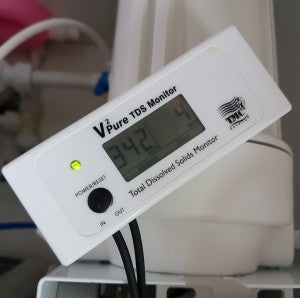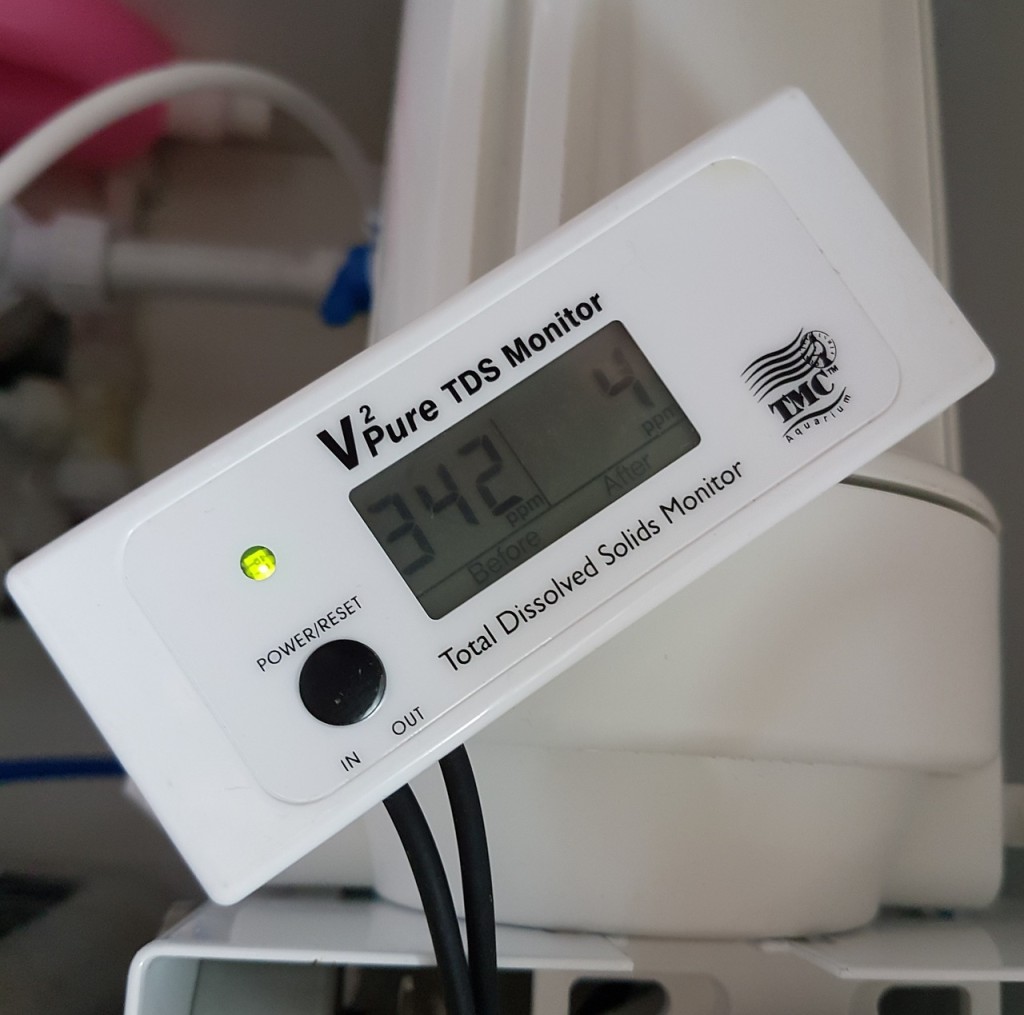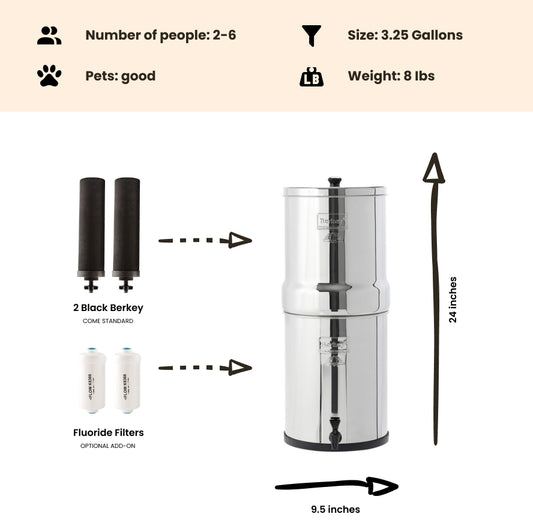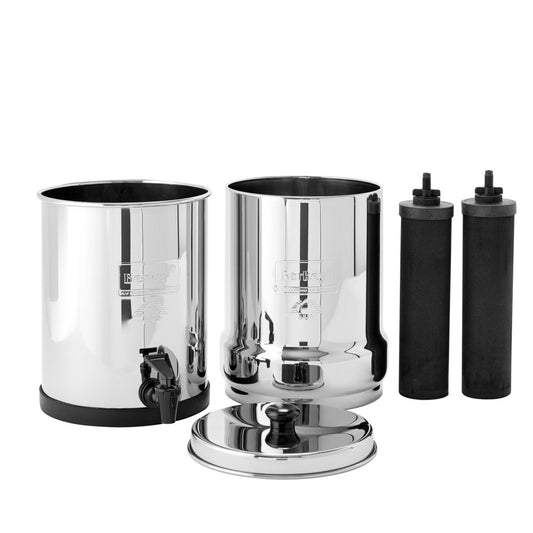
Should I be Concerned About TDS in my Water?
By Dan DeBaunShare
The amount of TDS, or Total Dissolved Solids, in water is commonly used as an indicator of water quality. TDS is a water quality measurement that shows the levels of total dissolved organic and inorganic compounds present in the water. Yet while TDS measurements may be useful for pinpointing high levels of dissolved industrial chemicals and salts, it is not necessarily a good indicator of all contaminants that may be present in drinking water. There are hundreds drinking water contaminants that will not be represented in TDS test results. Let's look at the benefits and uses of the TDS measurement, and whether it is suitable for determining how effective your drinking water filter is at removing contaminants, especially if you own a berkey water filter.
What is Total Dissolved Solids (TDS)?
Total Dissolved Solids (TDS) is the total measurement of all the organic and inorganic compounds that occur in a water sample, including minerals, salts and ions. The measurement is recorded by a TDS meter that measures water conductivity in parts per million (ppm). TDS measurements do not differentiate between different dissolved compounds, so the reading will include compounds such as road salt as well as naturally occurring minerals such as sodium and magnesium. A TDS measurement of 300-500 is considered normal as it will indicate the presence of naturally occurring dissolved compounds as well as potentially harmful ones. However, TDS measurements of 600 or higher is more likely to indicate that the levels of dissolved compounds could be a cause for concern.
The US Environmental Protection Agency (EPA) lists TDS as a secondary drinking water contaminant, meaning that while they are not likely to pose a significant health risk, there are still recommended acceptable levels for these contaminants, which are not enforced. Secondary drinking water contaminants are typically contaminants that are aesthetically unpleasant in drinking water or cause cosmetic or technical issues that are not harmful. For example, if your household water has a high iron content, the water may come out the taps with a distinct rust color, which although off-putting, won't make you ill. Also, ingesting water that is acidic will not do you any harm, but due to its highly corrosive nature it can harm household plumbing fixtures and fittings. By the same token, hard water (also harmless to drink) is extremely damaging to household appliances and water heaters.
What Does TDS Not Reflect?
TDS measurements are not a reflection of how safe your water is. Even if you have a TDS reading of 0, your water could still be contaminated with harmful toxins such as lead, arsenic, pesticides, pharmaceuticals and VOCs that would not reflect in a TDS test. A TDS test also won't reflect the presence of pathogenic bacteria, viruses and cysts that may be present.
What a TDS Measurement Does and Does Not Mean?
TDS measurements offer an easy, accessible method of determining the basic composition of water, and consequently it's a very popular water quality tool. If your TDS reading is 2,000, you know that your water contains very high levels of dissolved solids, some of which will more than likely be bad for your health. If, on the other hand, your TDS reading is 100, you will know that your drinking water contains low levels of dissolved organic and inorganic matter and is also lacking in minerals.
However, be warned that many unscrupulous salesmen use TDS measurements to trick consumers into believing they need an expensive, state-of-the-art water filter that is capable of removing dissolved solids, when this may not be the case at all. The fact of the matter is that a TDS reading on its own is not a true reflection of water quality. A more robust water test is needed to determine if your drinking water contains hazardous contaminants such as arsenic, copper and lead, for example. Getting a sample of your drinking water tested by a laboratory will provide a more accurate picture of the full range of contaminants present in your drinking water, and at what levels.
Why Does My TDS Reading Remain Unchanged After Filtering the Water?
Carbon filters are designed to remove toxic pollutants such as chlorine and its byproducts, VOCs and other hazardous contaminants from water. They are generally not designed to remove dissolved solids from water. Carbon filters typically have a micron rating that indicates how porous the media that makes up the filter cartridge is. A micron rating of 0.5, for example, will only allow particles measuring less than 0.5 microns through the filter pores and will remove particles larger than 0.5. The solid matter that is dissolved in water cannot be physically removed from the water by filtration.
How do I determine the performance of my carbon filter?
If you are questioning the efficiency of your water filter, you first need to consider what water contaminants or water quality issues you water filter is designed to address in order to evaluate its performance. Testing the efficiency of a carbon filter (like the black berkey filters) by measuring TDS of the filtered water is of no use whatsoever since a carbon filter does not address TDS.
Carbon filters rely on adsorption to remove impurities that give water a bad taste or smell. Carbon filters that have a fine micropore size are also able to remove microscopic contaminants and pathogens. If you want to know whether your carbon filter is functioning like it should, you need to focus on tasting and smelling the water to check whether it is up to par. If your filter is not working as efficiently as it should, you will notice the chemical aftertaste from chlorine when you drink the water. If that is the case, you probably need to replace the carbon filter cartridge. Good quality carbon filters, such as the Big Berkey range of filters, are also capable of removing a wide range of other contaminants, such as pathogenic microorganisms, lead and many other toxins that will not reflect on a TDS test. When using a carbon filter to remove lead from water, it is vitally important that you regularly test your water for lead, as this will not show up on a TDS measurement.
What Type of Filter System Do I Need to Remove TDS?
Reverse osmosis and water distillation are two water treatment options that can remove TDS. In the reverse osmosis process, water is forced through a semipermeable membrane that has tiny pores that are able to prevent dissolved particles from passing through. If you still have a high TDS measurement after filtering through a reverse osmosis system, it's time to replace your filter membranes. Water distillers on the other hand, remove TDS by converting water into steam, which then converts back into purified water sans the TDS contaminants after cooling. If you have water with dangerously high TDS levels, then a reverse osmosis water treatment system or water distiller may be a suitable option for you. However, in most cases, a good quality carbon filter with a fine micron rating is all you need to remove a wide range of contaminants that will render your water safe to drink.
-
Regular price $234.00 USDRegular priceUnit price / per
-
Regular price $327.00 USDRegular priceUnit price / per
-
Regular price From $367.00 USDRegular priceUnit price / per
-
Regular price From $408.00 USDRegular priceUnit price / per
-
Regular price From $451.00 USDRegular priceUnit price / per
-
Regular price From $478.00 USDRegular priceUnit price / per
-
Regular price $332.50 USDRegular priceUnit price / per
$350.00 USDSale price $332.50 USDSale

Dan DeBaun
Dan DeBaun is the owner and operator of Big Berkey Water Filters. Prior to Berkey, Dan was an asset manager for a major telecommunications company. He graduated from Rutgers with an undergraduate degree in industrial engineering, followed by an MBA in finance from Rutgers as well. Dan enjoys biohacking, exercising, meditation, beach life, and spending time with family and friends.
~ The Owner of Big Berkey Water Filters

















What's explanation on TDS measurement of osmosis filtered water is actually higher after filtering through carbon filter(0 TDS before linear carbon filter and around 20 TDS after in my case)? Is there something in granulated carbon that actually dissolves in water?
Hi Marcin -
It's most likely some slight carbon dust wash off of the carbon itself that's registering as TDS.
Thanks
Dan
This message is for “Dan” who replied to this. I’ve been running my berkey through over and over and the TDS reading is continually higher than my regular unfiltered tap water. It lowers very slightly, each time, but it’s taking forever…. I’ve called Berkey and no one addresses this concern of additional solids being added to my water. They just tell me to check it by filtering toxic red dye through my new Berkey :( Not going to do that. Your answer is the best one I’ve heard… but is this carbon dust toxic? Is it healthy to ingest or no?
Hi Sheri -
No, this carbon is not toxic and is used in supplements and hospitals to help detox the body. Also, the red dye would also be absorbed by the filters so would not contaminate any water flowing through them. Once a chemical or contaminant is absorbed by the filters, it is not released back out.
Thanks
Dan